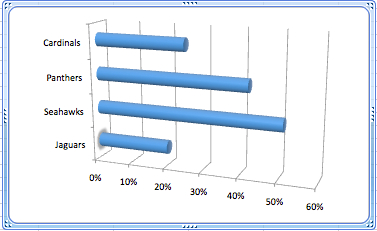Our Sunday Chart
Imagine someone tells you a t-shirt is $5.00. During class, my students figured out a seemingly endless list of messages that $5.00 conveys. Some said the price indicated poor quality. Others spoke of affordability. Status came up also.
The message that a price conveys came to mind when I read about NFL secondary-market ticket prices. In the following graph, I showed the teams with the highest percent increase in secondary-market ticket prices.

According to Barron’s, a substantial increase in secondary-market NFL ticket prices tells us which team is more likely to have a winning season. Looking at the past 2 seasons, they point out that 4 of the 5 teams with the biggest jumps in secondary-market ticket prices were Super Bowl champs and/or made the playoffs.
Our bottom line: When consumers’ prices and businesses’ costs fluctuate because of supply and demand, we have the price system. Reflecting what New Yorker financial writer James Surowiecki called The Wisdom of Crowds, the price system is a group phenomenon in which many individuals and businesses make buying and selling decisions for the same good or service. The result? Price conveys a message.
By contrast, when government establishes a price or prevents price from moving too high (a ceiling) or too low (a floor), then price gives consumers, sellers and producers little if any useful information.
The Message From NFL Ticket Prices

Elaine Schwartz
Elaine Schwartz has spent her career sharing the interesting side of economics. At the Kent Place School in Summit New Jersey, she was honored with an Endowed Chair in Economics. Just published, her newest book, Degree in a Book: Economics (Arcturus 2023), gives readers a lighthearted look at what definitely is not “the dismal science.” She has also written and updated Econ 101 ½ (Avon Books/Harper Collins 1995) and Economics: Our American Economy (Addison Wesley 1994). In addition, Elaine has articles in the Encyclopedia of New Jersey (Rutgers University Press) and was a featured teacher in the Annenberg/CPB video project “The Economics Classroom.” Beyond the classroom, she has presented Econ 101 ½ talks and led workshops for the Foundation for Teaching Economics, the National Council on Economic Education and for the Concord Coalition. Online for more than a decade. econlife has had one million+ visits.





